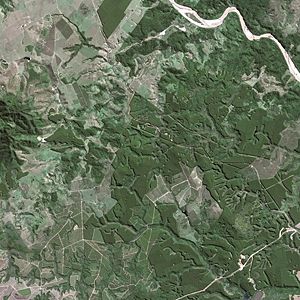Difference between revisions of "Atlantic Forest" - New World Encyclopedia
Vicki Phelps (talk | contribs) |
Mary Anglin (talk | contribs) m (Atlantic Forest (Brazil) moved to Atlantic Forest: Wikipedia name) |
(No difference)
| |
Revision as of 18:45, 2 January 2009
The Atlantic Forest (Mata Atlântica in Portuguese) is a region of tropical and subtropical moist forest, tropical dry forest, tropical savannas, and mangrove forests that extends along the Atlantic coast of Brazil from Rio Grande do Norte state in the north to Rio Grande do Sul state in the south, and inland as far as Paraguay and the Misiones Province of Argentina.
The Atlantic Forest region includes several variations of forests.
- Coastal restingas—low forests growing on stabilized coastal dunes.
- Coastal forests, also known as Atlantic moist forests_evergreen tropical forests with structures.
- Interior (inland) forests, also known as the Atlantic semi-deciduous forests—where many trees drop their leaves during the dry season.
- Atlantic dry forests farther inland—forming a transition between the arid Caatinga to the northeast and the Cerrado savannas to the east.
- Montane moist forests—occur in the Serra do Mar and across the mountains and plateaus of southern Brazil; are home to Araucaria and evergreen trees of the laurel (Lauraceae) and myrtle (Myrtaceae) families.
- Shrubby montane savannas—occur at the highest elevations.
The Atlantic Forest is unusual in that it extends as a true tropical rainforest to latitudes as high as 24°S. This is because the trade winds produce precipitation throughout the southern winter. In fact, the northern Zona da Mata of northeastern Brazil receives much more rainfall between May and August than during the southern summer.
Endangered species
The Atlantic Forest is now designated a World Biosphere Reserve because it contains a large number of highly endangered species, including the well-known marmosets and lion tamarins. It has been extensively cleared since colonial times, mainly for the farming of sugar cane and for urban settlements. What remains is estimated to be less than 10 percent of the original and is often broken into hilltop islands.
The Amazon Institute is active in reforestation efforts in the northeastern state of Pernambuco, Brazil. During 2007, Joao Milanez and Joanne Stanulonis planted 5,500 new trees in the mountains, adding to the what little remainsof the ancient forest.
During glacial periods, however, the Atlantic Forest is known to have shrunk to extremely small refugia in highly sheltered gullies, with most of the land area more recently occupied by the characteristic Atlantic Forest being occupied by dry forest or even semi-desert. Some maps even suggest the forest actually survived in moist pockets well away from the coastline, where its endemic rainforest species mixed with much cooler-climate species. Unlike refugia for equatorial rainforests, the refuges for the Atlantic Forest have never been the product of detailed identification.
Ecoregions
Tropical and subtropical moist broadleaf forests
- Araucaria moist forests
- Atlantic Coast restingas
- Bahia coastal forests
- Bahia interior forests
- Caatinga enclaves moist forests
- Paraná-Paraíba interior forests
- Pernambuco coastal forests
- Pernambuco interior forests
- Serra do Mar coastal forests
Tropical and subtropical dry broadleaf forests
- Atlantic dry forests
Tropical and subtropical grasslands, savannas, and shrublands
- Campos Rupestres montane savanna
Mangroves
- Bahia mangroves
- Ilha Grande mangroves
- Rio Piranhas mangroves
- Rio São Francisco mangroves
External links
- Amazon Institute
- Atlantic Forest (Conservation International)
- Atlantic Forest Foundation, help preserves the Atlantic Forest
- Atlantic forest (World Wildlife Fund)
- Conservation significance of the Atlantic Forest
- Embassy of Brazil in London: Atlantic Forest
- FirstFlora
- The Nature Conservancy: Atlantic Forest (with photo)
- The Reforestation efforts of 2 individuals in Pernambuco Joanne Stanulonis and João Milanêz
- UNESCO: Discovery Coast Atlantic Forest Reserves
Credits
New World Encyclopedia writers and editors rewrote and completed the Wikipedia article in accordance with New World Encyclopedia standards. This article abides by terms of the Creative Commons CC-by-sa 3.0 License (CC-by-sa), which may be used and disseminated with proper attribution. Credit is due under the terms of this license that can reference both the New World Encyclopedia contributors and the selfless volunteer contributors of the Wikimedia Foundation. To cite this article click here for a list of acceptable citing formats.The history of earlier contributions by wikipedians is accessible to researchers here:
The history of this article since it was imported to New World Encyclopedia:
Note: Some restrictions may apply to use of individual images which are separately licensed.
